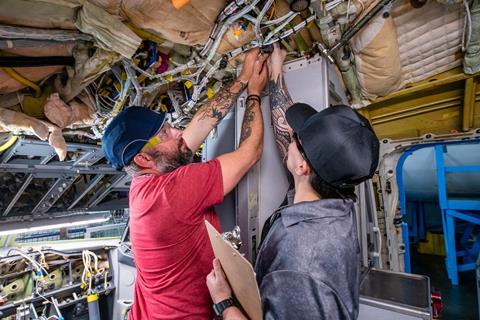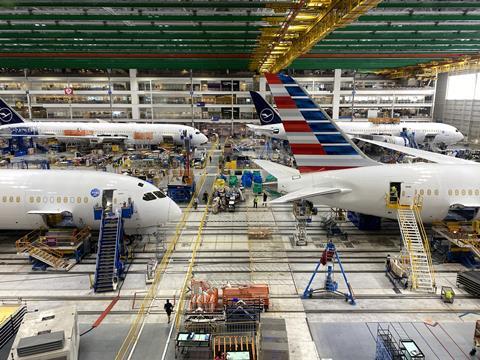As Boeing attempts to cure its ailing aircraft manufacturing practices, the company met with the USA’s Federal Aviation Administration on 30 May to present a “roadmap for continuous improvement”.
That was the description of FAA Administrator Mike Whitaker, who briefed reporters following the three-hour meeting in Washington, DC.
“We underscored that they must follow through on implementing corrective actions and transform their safety culture,” he says. “This is a guide for a new way for Boeing to do business.”
Whitaker pledges that the FAA will ensure “lasting changes” on the factory floors of Boeing’s facilities.
“I made clear to Boeing CEO Dave Calhoun and other senior leaders that this plan does not mark the end of our increased oversight of Boeing and its suppliers, but the beginning of the next chapter,” he says. “We will not approve production increases beyond the current cap until we’re satisfied.”

Boeing says its plan is based on findings from the FAA’s audits and recommendations from its panel review, in addition to feedback from its own employees, and covers increased workforce training, simplifying production processes, eliminating defects and shoring up its safety culture.
”Many of these actions are underway and our team is committed to executing on each element of the plan,” Calhoun says. ”It is through this continuous learning and improvement process that our industry has made commercial aviation the safest mode of transportation. The actions we are taking today will further strengthen that foundation.”
Stephanie Pope, chief of Boeing Commercial Airplanes, adds that the company’s employees “know best how to design, build and deliver safe, high-quality airplanes”.
”We are confident in the plan that we have put forward and are committed to continuously improving,” she says.
The FAA increased oversight of Boeing immediately following the 5 January blow-out of a mid-cabin door plug on Alaska Airlines flight 1282, blowing a hole in the fuselage of the 737 Max 9.
An ensuing investigation revealed that Boeing workers removed the Alaska jet’s door plug during the assembly process to allow workers for fuselage supplier Spirit Aerosystems to address a riveting issue. Boeing’s workers replaced the plug but apparently failed to bolt it in place.
The high-profile incident prompted the FAA to ground most of the global fleet of 737 Max 9s, including dozens of the jets operated by Alaska and United Airlines. Both carriers reported otherwise strong first quarter results tarnished by the roughly month-long grounding.
The event has proven seismic for the entire airline industry – and for Boeing itself. The Arlington, Virginia-headquartered airframer has announced that Calhoun will depart as CEO at the end of 2024, while former Boeing Commercial Airplanes boss Stan Deal has already been succeeded by Pope.
Boeing lost $355 million during the fist quarter amid its production slowdown.

FAA inspectors have also increased oversight of Boeing’s production processes and capped its 737 production at 38 jets monthly – though actual rates are reportedly well below that figure – until it is satisfied with Boeing’s progress.
“We will continue to make sure every airplane that comes off the line is safe and reliable, regardless of how many planes Boeing builds,” Whitaker says. “We need to see a strong and unwavering commitment to safety that endures over time.”
Boeing now requires a mandatory safety management system to identify hazards and manage risk. It has also strengthened a system that allows employees to anonymously report potential dangers without risk of reprisal and boosted oversight of its suppliers.
In the name of simplifying the flow of its production lines, Boeing has also cut steps to access build plans, reduced redundancies in its “quality-related command media” and cleared more time for managers to be on factory floors.
Meanwhile, it has implemented quality inspections of all 737 fuselages before they leave Spirit’s facilities in Wichita, and has reduced “travelled work” – tasks that are completed further along the production line than planned.
Boeing has hired thousands of factory workers following the major turnover seen during the Covid-19 pandemic and claims to be stepping up efforts to properly train relatively inexperienced technicians. It has recently added 300h of required training and deployed “workplace coaches and peer trainers” to its production lines.
In the bigger picture, Boeing is in talks to potentially re-acquire Spirit to better control production quality. Boeing in 2005 divested the business that became Spirit. Despite the deal’s complications – Spirit also provides major aircraft components for rival Airbus – the two sides could reach an agreement before the end of June.
Moving forward, FAA inspectors will maintain their increased presence at Boeing and Spirit’s facilities.
“This is about systemic change,” Whitaker says, “and there’s a lot of work to be done.”


































